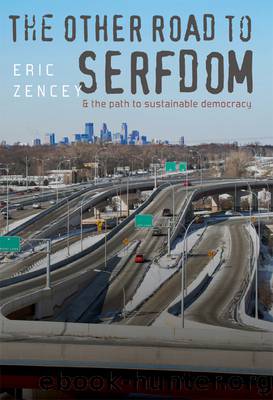The Other Road to Serfdom and the Path to Sustainable Democracy by Zencey Eric;

Author:Zencey, Eric;
Language: eng
Format: epub
Publisher: University Press of New England
So Infinite-Planet Theory prevailed and became the foundation of globalized economic practice, and the ecological footprint of the globalizing economy continued to increase, even though by many measures it had transgressed sustainable limits in the late 1970s or early 1980s. In the halls of power, scarcely a thought was given to forestalling the category of problems that Ehrlich and others had foretold. The solution to the problems of growth was going to be more growth. The consequences of this counterintuitive commitment have included a worldwide increase in human population and a reduction in the planetâs carrying capacityâchanges that will have large and unpleasant consequences and will increase the sum total of human pain and suffering in our civilizationâs course through history.
Thus, âthe most important bet in historyâ was also âthe bet that ruined the world,â in the words of Paul Kedrosky.
What had happened? Why did Ehrlich lose?
The bet has been analyzed and replayed quite a bitâwith notably varying results, depending on who is doing the analysis and replay. At the Property and Environment Research Center (which offers a fellowship named in honor of Simon), David McClintick and Ross B. Emmett reran the bet for each of the ten decades in the twentieth century, finding that Simon âwould have won five of the ten decades by large margins, and would have won the bet over the entire century.â They allowed that âto some extent Simon was lucky,â but they didnât take that as any sort of claim against Simonâs underlying theory: Simon hadnât claimed that prices would trend inevitably down without variation, just that they would trend inevitably down; âhe had said simply that he was more likely to win than to lose in any given decade.â
Other researchers, going at the issue a bit differently, came to a different conclusion. In 2008 Katherine Kiel and colleagues in the Department of Economics at Holy Cross used the same data tables but asked a different question: how did the prices of those metals fare in all possible ten-year periods for which we have data? From 1900 to 2007, there are ninety-eight such ten-year intervals, and in their analysis, Ehrlich and company would have won in 61.2 percent of those intervals, with an average return of 10.5 percentâa good deal greater than the return Simon got for the years 1980â1990. âThe story that the Ehrlich-Simon bet really tells is not that natural resource scarcity does not exist, but rather that in any gamble it is always better to be lucky than good. Simon happened to place the bet during one of the 38.2 percent of years since 1900 during which he would have won.â The most recent trend, visible since the late 1990s, is up: Simon would have won a ten-year bet in only four of the ten start years in that decade. And in the new millennium, so far Ehrlich is nine-for-nine.
As interesting as they are, attempts to rerun the Simon-Ehrlich bet are a bit beside the point, for they accept all of the fundamental conceptual flaws that lie behind the original bet itself.
Download
This site does not store any files on its server. We only index and link to content provided by other sites. Please contact the content providers to delete copyright contents if any and email us, we'll remove relevant links or contents immediately.
International Integration of the Brazilian Economy by Elias C. Grivoyannis(57393)
The Radium Girls by Kate Moore(10917)
Turbulence by E. J. Noyes(7058)
Nudge - Improving Decisions about Health, Wealth, and Happiness by Thaler Sunstein(6643)
The Black Swan by Nassim Nicholas Taleb(6205)
Pioneering Portfolio Management by David F. Swensen(5616)
Rich Dad Poor Dad by Robert T. Kiyosaki(5167)
Zero to One by Peter Thiel(4835)
Man-made Catastrophes and Risk Information Concealment by Dmitry Chernov & Didier Sornette(4749)
Secrecy World by Jake Bernstein(3789)
Millionaire: The Philanderer, Gambler, and Duelist Who Invented Modern Finance by Janet Gleeson(3576)
Skin in the Game by Nassim Nicholas Taleb(3479)
The Age of Surveillance Capitalism by Shoshana Zuboff(3432)
The Money Culture by Michael Lewis(3292)
Skin in the Game: Hidden Asymmetries in Daily Life by Nassim Nicholas Taleb(3273)
Bullshit Jobs by David Graeber(3190)
The Dhandho Investor by Mohnish Pabrai(3176)
The Wisdom of Finance by Mihir Desai(3087)
Blockchain Basics by Daniel Drescher(2896)
